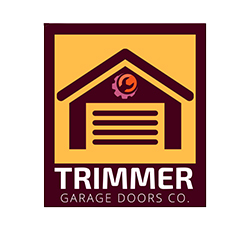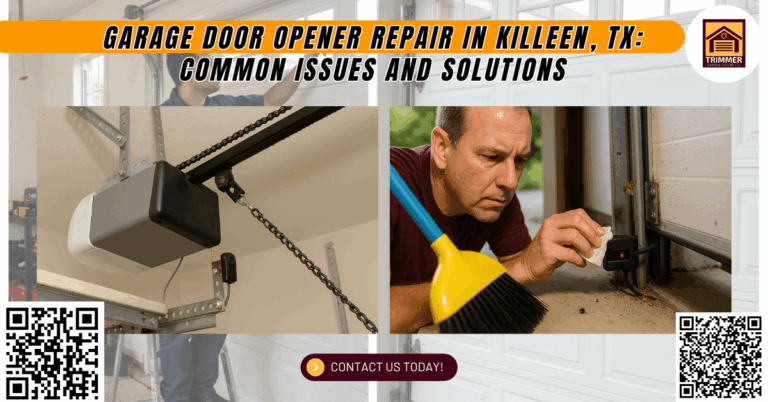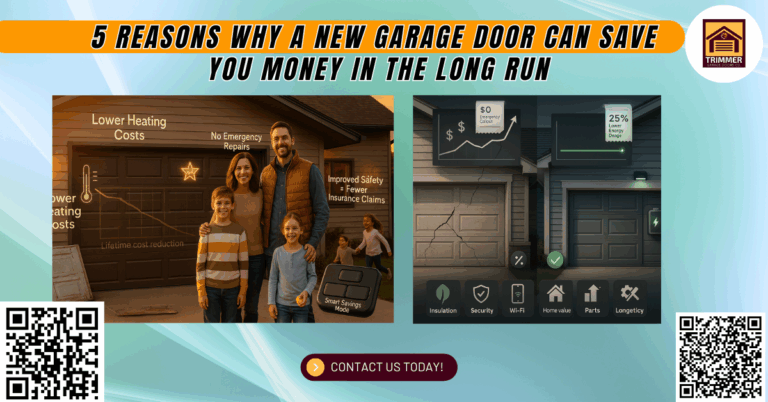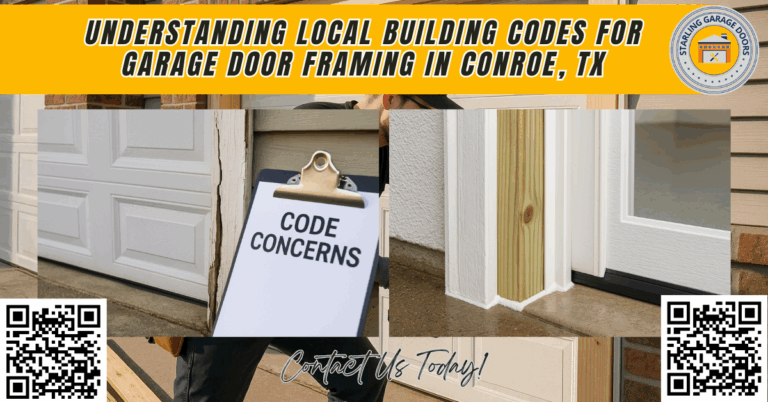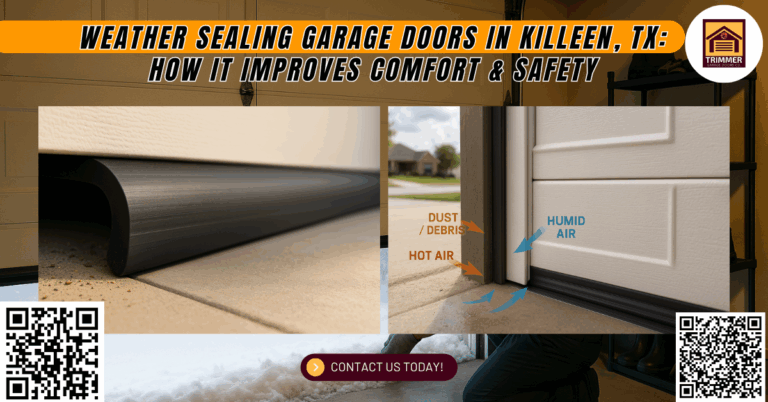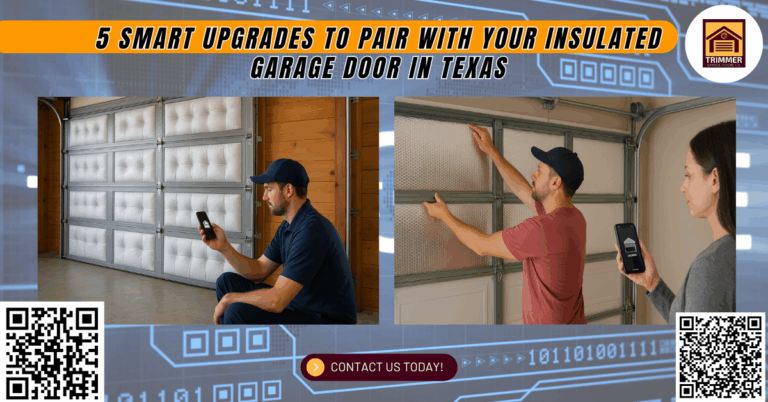At Trimmer Garage Doors Co., we once received a call from a new homeowner in Killeen, TX, just 48 hours after their professional residential garage door installation. They reported that their new garage door made grinding sounds and occasionally got stuck midway during operation. Upon inspection, we discovered the horizontal tracks weren’t fully level, which was placing uneven tension on the torsion springs. This minor installation error was quickly corrected, restoring smooth operation and peace of mind.
Situations like this highlight the importance of not only proper installation but also knowing how to identify potential problems early. A recent study by Home Innovation Research Labs revealed that over 70% of U.S. households use the garage door as their main entry point. That means the garage door system is one of the most frequently operated components of the entire home, which also makes it one of the most susceptible to wear and functional issues if not installed or maintained correctly.
If you’ve just had a residential garage door installation in Texas and are noticing some performance hiccups, don’t panic. Many post-installation concerns stem from minor adjustments or environmental changes. In this comprehensive guide, we’ll walk you through how to troubleshoot these issues effectively. You’ll also learn about the essential tools, materials, and safety steps needed to ensure a long-lasting, energy-efficient, and fully operational garage door system.
Common Post-Installation Garage Door Issues and How to Troubleshoot Them
Even the most professional installation can experience minor post-installation challenges. Here’s how to address them one step at a time.
1. Garage Door Doesn’t Open or Close Properly
Possible Causes:
- Misaligned safety sensors
- Inactive garage door opener
- Disrupted power connection
- Obstructed garage door tracks
Troubleshooting Steps:
- Check the Power: Make sure your garage door opener is securely plugged into a working outlet and that the circuit breaker hasn’t tripped.
- Inspect the Sensors: The safety sensors (photo eyes) located near the bottom panel must be aligned and free from dust, dirt, or obstruction. Even a spider web can cause a malfunction.
- Test the Remote and Wall Switch: If your remote works but the wall switch doesn’t (or vice versa), the problem could lie in wiring or dead batteries.
Pro Tip:
Inspect the garage door opening for debris that might hinder the door’s movement. Sometimes, leftover installation materials or packaging can obstruct movement without being immediately obvious.
2. Noisy Garage Door Operation
Common Sounds:
- Grinding
- Squeaking
- Popping or clanking
Likely Causes:
- Dry or unlubricated rollers, hinges, or springs
- Loose brackets, bolts, or nuts
- Misaligned or damaged vertical tracks or horizontal tracks
How to Fix:
- Lubricate All Moving Parts: Use a high-quality silicone or lithium-based lubricant on garage door springs, hinges, rollers, and brackets. Avoid using grease, as it attracts dirt.
- Tighten Hardware: Using a socket wrench, gently tighten all lag bolts, zinc hex lags, and hinges along the garage door sections.
- Check for Damage: Inspect each garage door panel, drum, and torsion tube to identify any signs of wear or bending. Replace any visibly damaged parts.
3. Door Opens Unevenly or Gets Stuck
Why It Happens:
- Uneven spring tension
- Misaligned vertical track
- Warped or damaged garage door panels
Solutions:
- Visual Inspection: Observe the door during opening and closing. If one side is lagging, the issue may lie in a broken or stretched torsion spring or cable.
- Check the Brackets: The flag brackets, center bracket, and track brackets must be flush and tightly secured to both the wall and ceiling.
- Evaluate the Track System: The vertical and horizontal tracks must be properly aligned. Even a small bend in the track can affect the door’s alignment and cause jerking or rubbing against the frame.
4. Door Reverses Midway or Doesn’t Reach the Floor
Signs:
- The garage door reverses immediately upon contact with the floor.
- The bottom panel doesn’t close all the way.
Causes:
- Improperly set close-force or limit settings
- Misaligned or blocked safety sensors
- Obstructions near the garage floor
Fixes:
- Adjust Opener Settings: Refer to your garage door opener’s manufacturer instructions to adjust the down force and limit switches.
- Realign Sensors: Use a level to align the photo-eye sensors. Ensure both LEDs are lit steadily.
- Inspect Weatherstripping: Swollen or detached bottom seals may prevent the door from sealing completely, affecting energy efficiency.
5. Remote Control or Keypad Not Responding
Typical Causes:
- Dead batteries
- Unprogrammed device
- Interference from nearby electronics
What to Do:
- Replace Batteries: Always the first step — it’s surprising how often this solves the problem.
- Reprogram Device: Follow the step-by-step guide in your garage door opener manual to reset the system and sync your remote or keypad.
- Reduce Interference: Move any large metal objects or wireless devices away from the opener’s receiver.
Troubleshooting Tips Specific to Texas Weather
Texas homes, particularly in Killeen and surrounding areas, experience diverse weather patterns that can impact garage door systems.
High Heat and Sun Exposure
- It can cause metal components like the torsion tube, panels, and brackets to expand.
- Insulated garage doors with high R-value reduce energy consumption and maintain energy efficiency in hot climates.
Cold Fronts
- Though infrequent, cold snaps can cause springs and rollers to contract, increasing friction.
- Regular maintenance and use of weather-resistant lubricants help prevent stiffness and noise.
Rain and Humidity
- Excess moisture can warp wooden doors, cause rust on metal parts, and affect electrical components of the garage door opener.
- Insulation and tight weather seals protect the garage interior and reduce long-term maintenance costs.
When You Need a Professional
While many tasks like lubrication, sensor alignment, or bolt tightening are manageable, the following should always be handled by a professional garage door technician:
- Adjusting or replacing torsion springs under high tension
- Repairing or rewinding cables and drums
- Replacing the garage door opener motor or circuit board
- Addressing structural issues with the garage opening, brackets, or ceiling mounts
Attempting these tasks without the necessary tools and experience risks damaging the garage door system and endangering personal safety.
Maintenance Tips to Prevent Future Problems
To avoid future issues after your garage door installation, implement these routine maintenance steps:
Perform Visual and Functional Checks
- Watch and listen to the garage door during operation.
- Check for uneven movement, jerky motions, or noisy operation.
Monthly Safety Tests
- Test the auto-reverse function by placing an object under the door as it closes.
- Disconnect the opener and manually lift the garage door to ensure smooth motion.
Lubricate Every 3–6 Months
- Apply lube to the rollers, hinges, springs, and brackets.
- Do not forget the torsion tube, cable drums, and flag bracket connections.
Annual Tune-Up
- Schedule a professional inspection to check spring tension, insulation condition, garage door sections, and the overall system.
- This is essential to maintaining curb appeal, performance, and energy efficiency.
How Can Trimmer Garage Doors Co. Help You?
At Trimmer Garage Doors Co., we believe that a successful garage door installation goes beyond the initial installation process. We stand behind our work with follow-up support and expert troubleshooting for any issue that arises after your residential garage door installation.
Here’s What Sets Us Apart:
✅ We use only top-grade garage door materials, including high-insulation panels, heavy-duty torsion springs, and weatherproof hardware.
✅ We offer step-by-step guidance post-installation to help you maintain your system.
✅ Our trained technicians handle everything from replacing an old door to setting up a high-tech garage door opener.
✅ We provide service throughout Killeen, TX, and neighboring regions with fast, affordable, and quality workmanship.
📍 Visit Us At:
1000 E Central Texas Expy, Killeen, TX 76541
📞 Call Us Today:
(430) 213-4007
Make the most of your new garage door investment by partnering with a team that ensures both a flawless installation and long-term performance. Let Trimmer Garage Doors Co. be your go-to for all things garage doors, from repairs and upgrades to professional garage door installation.
FAQs
1. How long does a typical residential garage door installation take?
A standard residential garage door installation usually takes about 4 to 6 hours. However, custom designs or unforeseen structural adjustments may extend this timeframe.
2. Can I reuse my existing garage door opener with a new door?
In many cases, existing garage door openers can be reused if they are compatible with the new door’s weight and design. It’s advisable to have a professional assess compatibility to ensure safe and efficient operation.
3. What maintenance is required after installing a new garage door?
Regular maintenance includes lubricating moving parts, checking the balance and alignment, and inspecting safety features. Performing these tasks every six months helps ensure longevity and optimal performance.
4. Are there specific safety features I should consider when installing a new garage door?
Modern garage doors often come equipped with safety features like auto-reverse mechanisms and motion detectors. Ensuring these features are properly installed and functioning is crucial for preventing accidents.
